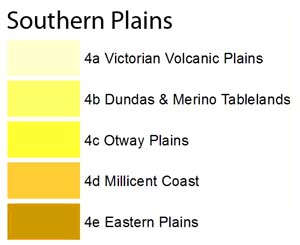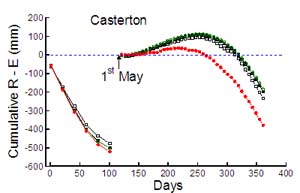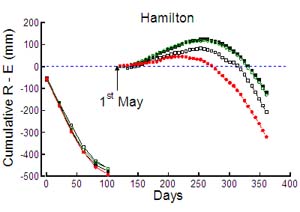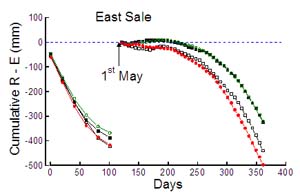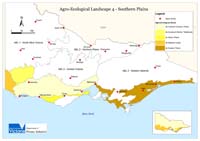Primary Production Landscapes Home | Southern Plains Home
Land use
Covering 51 local government areas and 6 catchment management authority regions, the major land use of the Southern Plains is production from dryland agriculture cropping, grazing and dairy) and forestry (77%). New blue gum forestry plantings are estimated to be 10,000 – 14,000 hectares per year. This has moderated since 8-10 years ago. Irrigated agriculture (8%) and intensive uses including horticulture and animal production (36% of Victoria’s land use) occur also. Rainfall varies from 450 mm west of Melbourne to 1100 mm at the foothills of the Southern Uplands. | |
Primary Production Landscapes
Victorian Volcanic Plains
Volcanic cones, lava flows and ash deposits are used mainly for grazing and cropping. Rainfall is higher and evaporation less than plains north of the divide.
Dundas & Merino Tablelands
The deeply dissected and weathered terrain has traditionally been used for grazing. Constraints to plant growth include soils with low pH and iron gravels that limit access to soil moisture.
Otway Plains
Rainfall within the plains is quite variable and the terrain diverse. Waterlogging is a major production constraint for prominent land uses including dairy and forestry.
Millicent Coast
Siliceous and calcareous plains and dunes are mainly used for dairy, forestry and fodder production. Soils and landforms continue into South Australia where viticulture also occurs.
Eastern Plains
Extensive alluvial systems from erosion of the Eastern Uplands generally receive higher rainfall and less evaporation than plains in the west. Grazing, forestry and dairy are main land uses on gradational and texture contrast soils. |
|
Management practices and issues in response to Climate Change
- Pasture management and persistence of perennial species on lighter soils is more difficult as plants are under greater stress due to drier seasons.
- The effective growing season is shortening with a drier start and finish. Waterlogging still occurs but is periodic and shorter in duration due to mild seasons and better growing conditions.
- Supplementary feed supply and expenses have increased in response to fodder and grain shortages. This feed is being sourced from other areas and is difficult to obtain.
- South-West Victoria is experiencing a substantial growth in the dairy industry.
- No significant changes to the dairy cycle have occurred although with shorter spring seasons calving is moving back into autumn.
- During spring and autumn, pastures are producing more grass but will this have an impact upon pasture persistence and quality of production?
- Deregulation of the dairy industry has translated into out of season milk demand and supply.
- Corporate research in dairy and New Zealand investment in establishing/acquiring properties for dairy has resulted in significant management style changes (e.g. heavier stocking rates).
- In dairy farming systems there appears to be a lack of ability to adapt stocking rates to drier seasons.
- Shortage of skilled labourers that often aren’t well paid.
- Water availability is a major issue due to the expansion of dairy farming areas in South-West Victoria.
- Road network requirements to meet growing industry demands.
- Currently there are no serious anti-pollution laws for effluent that are affecting farming.
|
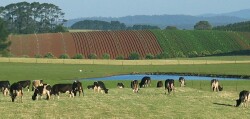
Cropping and Dairy cows- Neerim |
Future scenarios for farming systems
- Water shortages and competition with other agricultural industries for water resources is a major issue and potential limitation to future industry expansion.
- Highly promising (growth) industry due to global demand.
- Gradual change in intensification and modernisation of farming practices for dairy farming.
- Growth areas (e.g. Hawkesdale) are likely to be in previously marginal areas (previous beef and sheep production zones) and used as out paddocks and for fodder supply.
- Milk prices are favourable at present along with inputs. Concern is expressed if grain and fertiliser prices were to remain high or go higher and milk prices were to drop.
Victoria’s changing climate
Mean annual temperature (two scenarios from past records and one predicted scenario)
1970-1995 | 1996-2005 | 2050 A1FI prediction |
| | |
|
1970-1995 | 1996-2005 | 2050 A1FI prediction |
| | |
|
